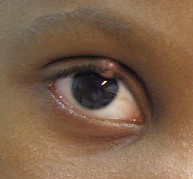Patient will present as → a 52-year-old male with a foreign-body sensation in the right eye. Over the last 3 weeks, he has had gradually increasing painless swelling around the right lower eyelid. Your examination shows a nontender discrete nodule on the right lower eyelid. There is no evidence of injection or discharge, and her visual acuity is normal.
To watch this and all of Joe Gilboy PA-C's video lessons you must be a member. Members can log in here or join now.
Chalazion are relatively painless lesions (in comparison to a hordeolum which is a "hot", painful lesion)
- They are characterized by their insidious onset with minimal irritation
- A chalazion is a noninfectious obstruction of a meibomian gland causing extravasation of irritating lipid material in the eyelid soft tissues with focal secondary granulomatous inflammation
- Remember: “C” = Chalazion = Chronic and “Cold” (versus hordeolum, which is “hot”, acute and not chronic)
- Will present as a hard, nontender eyelid swelling, often not very red
- Chalazion occur more commonly in the upper eyelid because of the presence of more sebaceous glands
"A good way to remember which is painful and painless: chalazion are too "lazy" to cause pain."
Diagnosis is clinical
- Will present as a hard, nontender eyelid swelling, often NOT very red
- Unlike a hordeolum (stye), a chalazion tends to have a more gradual onset, is less painful, and affects the middle part of the eyelid
Treat with warm compresses, and eyelid hygiene
- Injection of corticosteroid or incision + curettage may be necessary for large ones affecting vision
Question 1 |
The best way to differentiate between a Chalazion and a Hordeolum is
The presence of pus Hint: see answer for explanation | |
hordeolum only appear on the lower eyelid Hint: hordeolum may appear on the upper or lower eyelid | |
pain Hint: see answer for explanation | |
visual changes Hint: neither chalazion or hordeolum should cause visual changes, although if big enough they could partially obstruct the visual field. | |
both A and C |
Question 1 Explanation:
Chalazion are relatively painless lesions (in comparison to a hordeolum which is a "hot", painful lesion). They are characterized by their insidious onset with minimal irritation. A chalazion is noninfectious obstruction of a meibomian gland causing extravasation of irritating lipid material in the eyelid soft tissues with focal secondary granulomatous inflammation. A hordeolum (stye) is an acute, localized swelling of the eyelid that may be external or internal and usually is a pyogenic (typically staphylococcal) infection or abscess.
Question 2 |
Which of the following is not effective in the treatment of chalazion?
Systemic antibiotics | |
Warm compresses Hint: See answer | |
Incision and curettage Hint: See answer | |
corticosteroid therapy injection Hint: See answer |
Question 2 Explanation:
Hot compresses for 5 to 10 min 2 or 3 times a day can be used to hasten resolution of chalazia. Incision and curettage or intrachalazion corticosteroid therapy (0.05 to 0.2 mL triamcinolone 25 mg/mL) may be indicated if chalazia are large, unsightly, and persist for more than several weeks despite conservative therapy. Unlike Hordeolum, chalazion are not infectious and will not benefit from the use of oral antibiotic therapy, unless there is concern for surrounding infection.
Question 3 |
A patient presents with a nontender, painless, nodule involving a meibomian gland. Which of the following is the most likely diagnosis?
Chalazion | |
Dacryocystitis Hint: Dacryocystitis is an infection of the lacrimal sac due to obstruction of the nasolacrimal system. | |
Entropion Hint: Entropion is an outward turning of the lower lid. | |
Hordeolum Hint: A hordeolum is a bacterial inflammation of the base of the eyelash. |
Question 3 Explanation:
Chalazion is characterized by a hard, nontender swelling on the upper or lower lid with redness and swelling of the adjacent conjunctiva and is due to granulomatous inflammation of a meibomian gland.
There are 3 questions to complete.
|
List |
References: Merck Manual · UpToDate


 Lecture
Lecture

